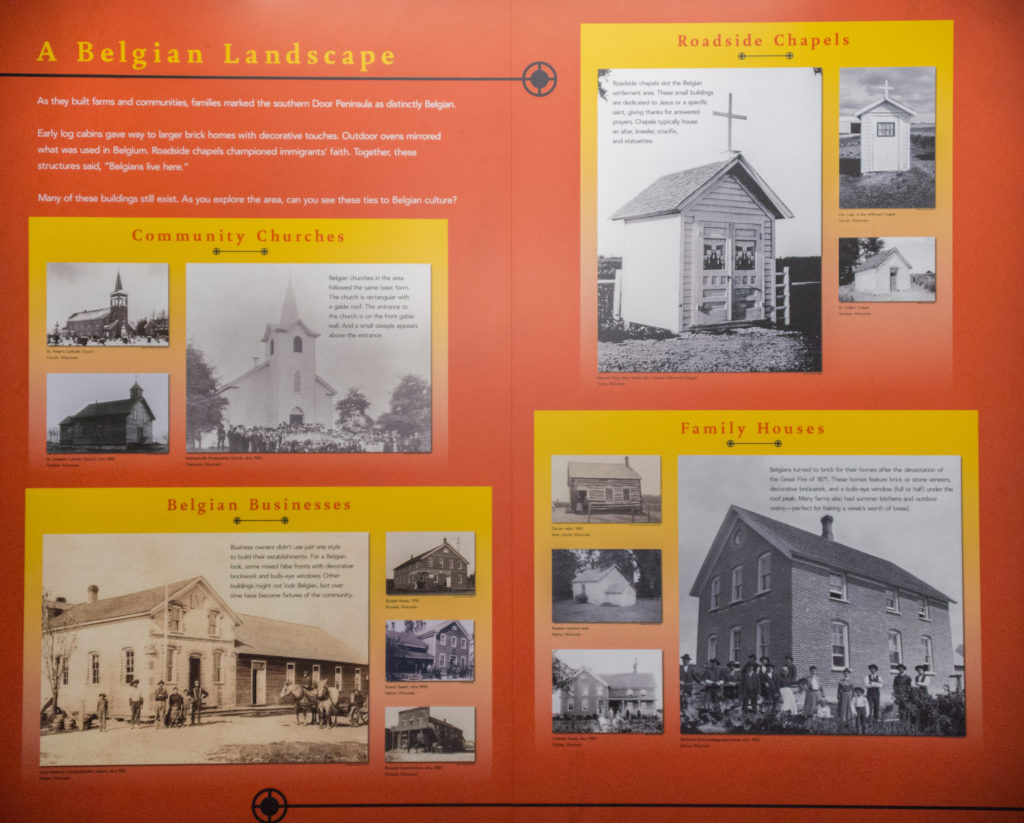Belgian Heritage Center Unveils New Historic Exhibits
- Share
- Tweet
- Pin
- Share

They call it “The Night America Burned.”
On Oct. 8, 1871, it seemed few places in the Midwest were left untouched by one of the great infernos of that evening.
There was the Great Chicago Fire that burned until Oct. 10, 1871, claiming nearly 300 lives, 17,500 buildings and 2,000 acres of land. There was the Great Michigan Fire, which swept through the Michigan towns of Holland, Port Huron and Manistee, killing upwards of 100.
And here, the deadliest fire in United States history was sweeping through Northeast Wisconsin. The Peshtigo Fire, made up of a series of fires in and around the Peshtigo area (including Brown, Kewaunee and Door counties), claimed a dozen rural communities and killed an estimated 1,700 to 2,500 people. In Door County, it completely wiped Williamsonville (then located northeast of Brussels) off the map, along with 60 of the village’s 77 residents.
The blazing inferno came just a few years after the mass settlement of approximately 15,000 Belgians in Northeast Wisconsin, including local areas of Brussels, Namur, Rosiere, Lincoln, Champion and Dyckesville.

The stories of survival and loss from the Peshtigo Fire, and the efforts to rebuild these communities, have lived on in historical literature and family stories for nearly a century-and-a-half. Door County resident Barb Chisholm is the great-granddaughter of two survivors of the Peshtigo Fire and on the 145th anniversary of the fire on Saturday, Oct. 8, will be the featured speaker of the Belgian Heritage Center’s grand opening of its permanent historical exhibits.
“My grandfather lived with us. It was his father who survived,” Chisholm said. “They survived the fire with their first child, who was six months old. They passed him back and forth while they were in the well so he wouldn’t get burned. Then they got out and there was nothing there; their barn, their house, their animals, the little bit of equipment they had, all was gone.
“Interestingly enough,” she added. “They got state help until May of the following year and then the state said, that’s it, with your own good right hand, go out and make a living. This is all we’re giving you. And they did. They prospered.”
Success in the face of adversity is a significant theme of the development of the Belgian settlement in Wisconsin, and of the new historical exhibits, which detail their journey to America and what transpired after they arrived: $1.25-per-acre land purchases, the Peshtigo Fire, roadside chapels and the back-breaking labor necessary to make it all work.

For evidence of the Belgian settlement in Southern Door, look no further than architecture and roadside chapels.
The exhibits represent two years of fundraising efforts and one year of collaboration between the Belgian Heritage Center and two exhibit design teams: Balance Studios in Green Bay and St. Paul-based Split Rock Studios.
Through photos, maps and artifacts, they tell the story of the approximately 15,000 Belgians who traveled to Northeast Wisconsin to escape unemployment, famine and limited land ownership opportunities in their homeland and in the process, laid the foundation for what is now considered the largest Belgian settlement in the United States.
Although the story of Belgians in Door County dates back to the early 1850s, the story of the group responsible for sharing these exhibits is far more recent. In fact, the Namur Belgian Heritage Foundation (which runs the Belgian Heritage Center) has only been operating since 2010. The nonprofit was formed in response to the closing and decommission of St. Mary of the Snows church, the Catholic centerpiece and of the Namur Belgian community that sat vacant for 10 years before facing demolition.
 “A group of local people got together and we thought, it’s right in the heart of the Belgian Historic District in Northeast Wisconsin and it’s on the National Register of Historic Places,” board chairman Bill Chaudoir recalled. “So we said, this would be a good place to help tell the Belgian settlement story of this region.”
“A group of local people got together and we thought, it’s right in the heart of the Belgian Historic District in Northeast Wisconsin and it’s on the National Register of Historic Places,” board chairman Bill Chaudoir recalled. “So we said, this would be a good place to help tell the Belgian settlement story of this region.”
The past six years have seen three of the group’s major projects come to fruition: development of a reuse and fundraising plan (they have raised nearly half of their $700,000 goal), significant stabilization of the building, and creation of permanent historic exhibits. The organization operates alongside its “sister group,” the Peninsula Belgian-American Club, formed in 1964.
The group has a wish list of nine future interactive exhibits, spanning from family history stories to Belgian myths and lore. Two of those plans – for a historical photo gallery and oral history and Walloon language stories – have already been commissioned. Walloon is a language similar to French that was spoken by many of the original Belgian settlers in the area, and is considered an endangered language, as there is no written record for it and many of its fluent speakers are in their 70s or older, according to Chaudoir.
That’s why the Belgian Heritage Center has teamed up with the University of Wisconsin – Eau Claire to document the language by conducting interviews with Wisconsin Walloon speakers.
“We have to do it now while we still have Walloon speakers around,” Chaudoir said. “My parents’ generation, that generation all spoke Walloon but my generation didn’t carry it on so it’s dying. We’re hoping to come up with a written language that we can actually use as a curriculum in local schools to help preserve the language.”
Both the Peshtigo Fire and the Walloon Project will be highlights of the Oct. 8 grand opening ceremony. Following the 10 am ribbon cutting ceremony, Chisholm will offer a historic presentation on the devastating fire and at 12:30 pm, UW-Eau Claire professor Kelly Biers will share information on his work on the Walloon Language Preservation Project. There will also be door prizes throughout the day.

The Belgian Heritage Center in Namur. Photo courtesy of the Belgian Heritage Center.
The Belgian Heritage Center continues raising funds for additional building improvements, reconstruction of the church’s historic steeple, restoration of the original indoor paint scheme, and construction of an outdoor event pavilion and summer kitchen.
In the meantime, they will carry on their established traditions hosting waffle breakfasts, booyah events, and their popular Belgian Kermiss harvest celebration while promoting the rich heritage of Belgians in Wisconsin.
“We’re pretty proud of this,” Chaudoir said. “We spent the first few years just trying to stabilize the building. It was abandoned for 10 years. We did the windows, the heating system, electrical, plumbing, the roof – all that needed upgrading so, to me, the most amazing part of our story is how the local community and the volunteers stepped up. We had volunteers tuckpointing our building, which I think is unheard of. These Belgians are known for being hard workers and crafty, they-can-fix-anything kind of people and they did that.
“We think if it wasn’t for our group coming together, this building may not be here and it’s an important building and an important district.”
The grand opening celebration takes place from 10am – 4pm on Saturday, Oct. 8, at the Belgian Heritage Center, 1255 County Hwy. DK in Brussels. The center will be open during the month of October on Fridays, Saturdays and Sundays from 10am – 4pm. Admission is $5 for adults and $3 for children (ages 6-18). For more information, visit BelgianHeritageCenter.org.


